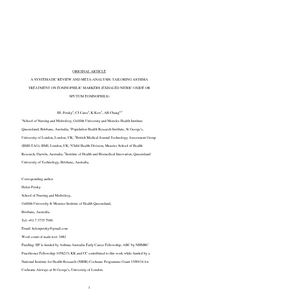Petsky, HL; Cates, CJ; Kew, KM; Chang, AB
(2018)
Tailoring asthma treatment on eosinophilic markers (exhaled nitric oxide or sputum eosinophils): a systematic review and meta-analysis.
Thorax, 73 (12).
pp. 1110-1119.
ISSN 1468-3296
https://doi.org/10.1136/thoraxjnl-2018-211540
SGUL Authors: Cates, Christopher Joseph
![[img]](https://openaccess.sgul.ac.uk/109882/7.hassmallThumbnailVersion/Accepted%20with%20figures%202018%20Thorax.pdf)  Preview |
|
PDF
Accepted Version
Available under License ["licenses_description_publisher" not defined].
Download (598kB)
| Preview
|
Abstract
BACKGROUND: Asthma guidelines guide health practitioners to adjust treatments to the minimum level required for asthma control. As many people with asthma have an eosinophilic endotype, tailoring asthma medications based on airway eosinophilic levels (sputum eosinophils or exhaled nitric oxide, FeNO) may improve asthma outcomes. OBJECTIVE: To synthesise the evidence from our updated Cochrane systematic reviews, for tailoring asthma medication based on eosinophilic inflammatory markers (sputum analysis and FeNO) for improving asthma-related outcomes in children and adults. DATA SOURCES: Cochrane reviews with standardised searches up to February 2017. STUDY SELECTION: The Cochrane reviews included randomised controlled comparisons of tailoring asthma medications based on sputum analysis or FeNO compared with controls (primarily clinical symptoms and/or spirometry/peak flow). RESULTS: The 16 included studies of FeNO-based management (seven in adults) and 6 of sputum-based management (five in adults) were clinically heterogeneous. On follow-up, participants randomised to the sputum eosinophils strategy (compared with controls) were significantly less likely to have exacerbations (62 vs 82/100 participants with ≥1 exacerbation; OR 0.36, 95% CI 0.21 to 0.62). For the FeNO strategy, the respective numbers were adults OR 0.60 (95% CI 0.43 to 0.84) and children 0.58 (95% CI 0.45 to 0.75). However, there were no significant group differences for either strategy on daily inhaled corticosteroids dose (at end of study), asthma control or lung function. CONCLUSION: Adjusting treatment based on airway eosinophilic markers reduced the likelihood of asthma exacerbations but had no significant impact on asthma control or lung function.
Statistics
Item downloaded times since 08 Jun 2018.
Actions (login required)
 |
Edit Item |



